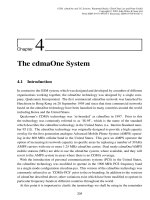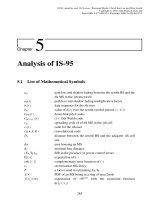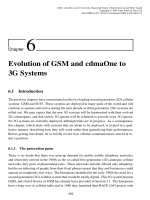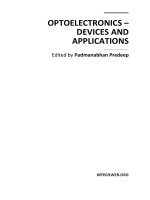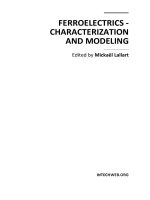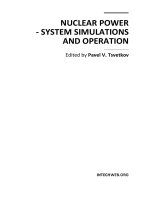CDMA 120 – cdmaOne and CDMA2000 Concepts and Terminology phần 1 pdf
Bạn đang xem bản rút gọn của tài liệu. Xem và tải ngay bản đầy đủ của tài liệu tại đây (1.8 MB, 22 trang )
CDMA 120
cdma university
CDMA 120 –
cdmaOne and CDMA2000
Concepts and Terminology
CDMA 120 –
cdmaOne and CDMA2000
Concepts and Terminology
Student Guide
80-13321-1 X11
QUALCOMM
£
is a registered trademark and service mark of QUALCOMM Incorporated.
All other names are the property of their respective owners.
Export of this technology may be controlled by the United States Government.
Diversion contrary to U.S. law prohibited.
Material Use Restrictions
These written materials are to be used only in conjunction with the associated instructor-led
class. They are not intended to be used solely as reference material.
No part of these written materials may be used or reproduced in any manner whatsoever
without the written permission of QUALCOMM Incorporated.
Copyright © 2002 QUALCOMM Incorporated. All rights reserved. Printed in the United States
of America.
QUALCOMM Incorporated
5775 Morehouse Drive
San Diego, CA 92121
U.S.A.
CDMA 120 – cdmaOne and CDMA2000 Concepts and Terminology
Table of Contents
80-13321-1 X11
© 2002 QUALCOMM Incorporated
3
CDMA 120
cdma university
CDMA.HELP
z Email hotline resource to assist our CDMA customers
worldwide
z Experienced CDMA engineers in our Engineering Services
Group will answer your technical questions on topics
including:
–Industry Standards
–Infrastructure Design
–Voice Quality
–System Design
–Network Planning
–Network Optimization
–Test Engineering
–Training
CDMA 120 – cdmaOne and CDMA2000 Concepts and Terminology
Table of Contents
80-13321-1 X11
© 2002 QUALCOMM Incorporated
4
This page left blank intentionally.
CDMA 120 – cdmaOne and CDMA2000 Concepts and Terminology
Table of Contents
80-13321-1 X11
© 2002 QUALCOMM Incorporated
5
Table of Contents
Section 1: Introduction
Section 1: Introduction 1-1
Course Overview 1-2
Recommended Reading List 1-5
Comments/Notes 1-7
Section 2: Background
Section 2: Background 2-1
Section Introduction 2-2
cdmaOne 2-3
IS-95A 2-4
ANSI J-STD-008 2-6
TIA/EIA-95 2-7
CDMA2000 2-8
Multiple Access Methods 2-9
Overview of CDMA 2-11
Example CDMA Network Architecture 2-12
The “Cellular” Concept and “Sectors” 2-13
cdmaOne Overview and Terminology 2-15
A/D 2-17
Error Detection Codes 2-18
Spread Spectrum Techniques 2-20
Binary Phase Shift Keying 2-23
QPSK 2-24
OQPSK 2-25
Analog and RF Concepts 2-26
Radio Channel Characteristics 2-28
Coherent / Non-Coherent Detection 2-29
Signal-to-Noise Ratio 2-30
Correlation 2-31
E
b
/N
0
2-32
Applications for cdmaOne 2-33
U.S. Cellular Frequency Allocations 2-34
The Cellular CDMA Channel 2-35
U.S. PCS Frequency Allocations 2-37
The PCS CDMA Channel 2-38
Fixed Wireless (Wireless Local Loop) 2-40
Section Review 2-41
Comments/Notes 2-42
Section 3: Codes in cdmaOne
Section 3: Codes in cdmaOne 3-1
Section Introduction 3-2
AND Function 3-4
CDMA 120 – cdmaOne and CDMA2000 Concepts and Terminology
Table of Contents
80-13321-1 X11
© 2002 QUALCOMM Incorporated
6
Orthogonal Codes 3-5
Generation of Orthogonal Codes 3-6
Orthogonal Codes 3-7
Orthogonal Spreading 3-8
Channelization Example 3-9
Orthogonal Spreading Example 3-12
Despreading Example 3-13
PN Codes 3-14
PN Code Generation 3-16
Masking 3-19
Section Review 3-21
Comments/Notes 3-22
Section 4: The cdmaOne Physical Layer
Section 4: The cdmaOne Physical Layer 4-1
Section Introduction 4-2
CDMA Channel Generation 4-3
Forward Link Channels 4-4
Pilot Channel 4-6
Sync Channel 4-7
Paging Channel 4-8
Forward Traffic Channel 4-9
Medium Data Rate Option Overview 4-12
Reverse Link Channels 4-13
Reverse Traffic Channel 4-15
Access Channel 4-16
Section Review 4-17
Comments/Notes 4-18
Section 5: Attributes and Techniques of CDMA
Section 5: Attributes and Techniques of CDMA 5-1
Section Introduction 5-2
Frequency Reuse 5-3
CDMA Frequency Reuse 5-5
Power Control 5-6
Soft Handoffs 5-9
Multipath 5-11
Variable Rate Vocoder 5-13
Vocoder Rates 5-15
CDMA Speech Codecs 5-16
Rate Sets 5-17
Multiplexing 5-19
Capacity 5-23
Capacity of Conventional Systems 5-24
CDMA Capacity 5-25
Coverage 5-26
CDMA 120 – cdmaOne and CDMA2000 Concepts and Terminology
Table of Contents
80-13321-1 X11
© 2002 QUALCOMM Incorporated
7
Section Review 5-27
Comments/Notes 5-28
Section 6: Call Processing and Registration
Section 6: Call Processing and Registration 6-1
Section Introduction 6-2
Overview of Call Processing 6-3
Initialization State 6-4
Idle State 6-6
Access Channel Processing 6-7
Traffic Channel Message Structure 6-8
Determining Mobile Location 6-9
Overview of Registration 6-11
Systems and Networks 6-12
Roaming 6-13
Types of Registration 6-15
Autonomous Registration 6-16
Non-Autonomous Registration 6-17
Section Review 6-18
Comments/Notes 6-19
Section 7: cdmaOne Handoffs
Section 7: cdmaOne Handoffs 7-1
Section Introduction 7-2
Types of CDMA Handoffs 7-3
Idle Handoffs 7-4
Access Handoffs 7-5
Traffic Channel Handoffs 7-6
The Pilot Searching Process 7-10
Handoff Signaling 7-14
Section Review 7-16
Comments/Notes 7-17
Section 8: CDMA2000 Overview
Section 8: CDMA2000 Overview 8-1
Section Introduction 8-2
What is Third Generation? 8-3
3rd Generation Standards 8-4
CDMA2000 8-5
CDMA2000 1x Voice Capacity 8-6
CDMA2000 Physical Layer 8-7
Spreading Rate 1 and Spreading Rate 3 8-8
Physical and Logical Channels 8-9
CDMA2000 Logical Channel Naming 8-10
CDMA2000 Physical Channel Naming 8-11
CDMA2000 Logical to Physical Channel Mapping 8-12
CDMA 120 – cdmaOne and CDMA2000 Concepts and Terminology
Table of Contents
80-13321-1 X11
© 2002 QUALCOMM Incorporated
8
Available Forward Link Code Channels 8-13
Radio Configurations (RC) 8-14
Forward Link Radio Configurations 8-15
Reverse Link Radio Configurations 8-16
Dedicated Channels and Standard Services 8-17
RL Closed Loop Power Control 8-18
Forward Link Fast Power Control 8-19
Transmit Diversity 8-20
Benefits of Transmit Diversity 8-21
Walsh Notation 8-22
Variable Walsh Spreading 8-23
Walsh Limitations 8-24
Quasi-Orthogonal Functions (QOFs) 8-25
Walsh Facts 8-26
Turbo Encoder 8-27
Forward Link Physical Layer Key Characteristics 8-28
New Common Channels 8-29
Why New Forward Common Channels? 8-30
New Common Channels Structure 8-31
Backward-Compatible Forward Link Code Channels 8-32
New Forward Link Common Channels 8-33
New Forward Link Dedicated Channels 8-34
Forward Link Operation 8-35
Reverse Link Characteristics 8-36
Reverse Link Channels 8-38
Reverse Common and Dedicated Channels 8-39
Illustration of Reverse Link Operation 8-40
Data Multiplexing 8-41
Access Channel Procedures 8-42
What is 1xEV-DO? 8-43
1xEV-DO Is Data Optimized 8-44
1xEV-DO Data Rates 8-45
Co-located 1xEV-DO and CDMA2000 1x/IS-95 Carriers 8-46
1xEV-DO and IS-2000 Family Overlay 8-47
Comparison of Forward Links 1x vs. 1xEV-DO 8-48
Forward Link Slot Structure 8-49
Section Review 8-50
Comments/Notes 8-51
Section 9: Course Summary
Section 9: Course Summary 9-1
Comments/Notes 9-3
